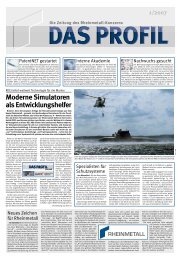PDF [2.5 MB] - Kolbenschmidt Pierburg AG
PDF [2.5 MB] - Kolbenschmidt Pierburg AG
PDF [2.5 MB] - Kolbenschmidt Pierburg AG
You also want an ePaper? Increase the reach of your titles
YUMPU automatically turns print PDFs into web optimized ePapers that Google loves.
Systems from STN Atlas ElektronikGmbH<br />
Life rescue . . .<br />
(Continued from page 12)<br />
degrees 22 minutes east, 21 knots,<br />
distance 16 nautical miles”. The position<br />
is registered on the electronic chart<br />
of the Alfried Krupp and the foreman<br />
calculates how long it will take for the<br />
freighter to reach the search area.<br />
Every minute counts in such situations:<br />
even with modern rescue vests,<br />
the chances of survival in water are limited.<br />
Besides the obvious danger of<br />
drowning (that is reduced significantly<br />
by the rescue vests) there is the very<br />
serious risk of hypothermia which can<br />
start after only a few minutes at water<br />
temperatures below ten degrees Celsius.<br />
Even if rescue services get there<br />
fast, it may still be too late. This is why<br />
perfect coordination between all those<br />
involved in a rescue operation is essential,<br />
why radio messages should<br />
contain unmistakable instructions to<br />
avoid confusion and why everybody<br />
has to know exactly what to do. In our<br />
example, the exercise was finished after<br />
about an hour and a half – with a<br />
positive outcome. All who were on board<br />
the aircraft have been rescued<br />
thanks to the good coordination of the<br />
rescue mission.<br />
Heiner Lübbers of the German Lifeboat<br />
Institution knows that operations<br />
are not always this successful. Communication<br />
problems are often encountered<br />
in reality, ultimately also<br />
because the situation in shipping has<br />
changed. “Sometimes, we can count<br />
ourselves lucky to find a crew member<br />
Shipwreck – this meant certain<br />
death for sailors on the coast of<br />
the North and Baltic Seas in the<br />
middle of the nineteenth century. Cargo<br />
ships, steamers, sailing boats and barges<br />
which had run aground were really<br />
only interesting for those on shore as<br />
the general rule was “finders keepers”<br />
for any cargo washed ashore. Besides,<br />
cross-border cooperation was literally<br />
unknown in those days. The rulers of<br />
the duchies were only marginally interested<br />
in the welfare of their sailors.<br />
Things changed after the sailing vessel<br />
Alliance hit the dreaded Borkum-<br />
Riff off the North Sea coast and sank in<br />
September 1860. Not one single crew<br />
member survived the accident. This in-<br />
Newsline<br />
on board a freighter<br />
who can speak<br />
at least some English”.<br />
Ships are increasinglyoperated<br />
under a foreign<br />
flag, they are registered<br />
in countries<br />
with relatively<br />
slack rules regarding the training standards<br />
of their crews, shipping companies<br />
exert considerable time pressures<br />
on their captains – all these aspects<br />
have changed shipping drastically in<br />
the last years. Nevertheless any ship<br />
which is sufficiently near the location<br />
of an accident is obliged to come to<br />
the rescue. All captains stick to this<br />
iron rule – after all, they may face the<br />
same situation one day.<br />
Simulator training is mandatory for<br />
the foremen of the German Lifeboat Institution.<br />
Every foreman has to repeat<br />
such a training every other year. The<br />
engineers of rescue cruisers take part<br />
whenever possible. This is important<br />
because the tasks on board ship can<br />
change and ideally every crew member<br />
should be able to take over practically<br />
any job; it is quite conceivable<br />
that the foreman leaves the task of radio<br />
coordination to another crew<br />
member because he is busy maneuvering<br />
the ship.<br />
In addition to the installation of an<br />
advanced training center for rescue<br />
services, the Caesar project has also<br />
involved a complete renewal of the<br />
cident prompted the navigation teacher<br />
Adolph Bermpohl, the lawyer Carl<br />
Kuhlmay, the journalist Arwed Eminghaus<br />
and the senior customs inspector<br />
Georg Breusing to publish an appeal<br />
for the establishment of a maritime rescue<br />
organization for Germany. Associations<br />
for the rescue of shipwrecked<br />
persons were thereupon founded in<br />
Emden, Hamburg, Bremerhaven and<br />
on the East Frisian Islands; in the year<br />
1865 the German Lifeboat Institution<br />
(DGzRS) was then established in Bremen<br />
where the organization still has<br />
its headquarters today.<br />
Rescue stations were established<br />
along the coast, equipped with rowing<br />
boats and launching devices to<br />
13<br />
The rescue cruiser Vormann-Steffens in operation.<br />
maritime rescue control center in Bremen<br />
from where rescue services in the<br />
German territory of the North Sea and<br />
Baltic Sea are coordinated; whenever<br />
a distress signal is transmitted, this is<br />
received directly by the control center<br />
of the German Lifeboat Institution.<br />
Technical processes have changed<br />
considerably in recent years. Distress<br />
messages are rarely received by VHF<br />
radiotelephony nowadays; instead of<br />
this, international regulations demand<br />
that ships of a certain size should have<br />
modern electronic distress systems<br />
on board. The alarm is triggered at the<br />
push of a button, within a matter of seconds<br />
rescue services will know not<br />
only the name of the ship in distress<br />
but also the type of emergency and<br />
the exact position. Even if the crew<br />
does not have the time to send a message,<br />
the automatic distress buoys<br />
that are activated as soon as a ship<br />
starts to sink will do the job. It is then<br />
up to the officers working at the MRCC<br />
in Bremen to assess just how serious<br />
the situation is and who can assist<br />
best in which way – systems from STN<br />
Atlas help them to do this.<br />
shoot the rescue lines on board ships<br />
in distress. Whereas maritime rescue<br />
services were nationalized in the German<br />
Democratic Republic after World<br />
War II, the principle of voluntary service<br />
introduced by the founding mem-<br />
DGzRS: A team<br />
driven by idealism<br />
bers of the German Lifeboat Institution<br />
was upheld in the Federal Republic<br />
of Germany. The institution still<br />
depends exclusively on donations –<br />
and by tradition, the German president<br />
has always been the patron of<br />
the Lifeboat Institution.


![PDF [2.5 MB] - Kolbenschmidt Pierburg AG](https://img.yumpu.com/8112793/13/500x640/pdf-25-mb-kolbenschmidt-pierburg-ag.jpg)





![PDF [1.6 MB] - Kolbenschmidt Pierburg AG](https://img.yumpu.com/8657804/1/171x260/pdf-16-mb-kolbenschmidt-pierburg-ag.jpg?quality=85)
![PDF [2.4 MB] - Kolbenschmidt Pierburg AG](https://img.yumpu.com/8295864/1/184x260/pdf-24-mb-kolbenschmidt-pierburg-ag.jpg?quality=85)






